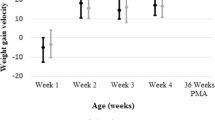Abstract
Objective:
We studied 123 neonates with atresias of the gastrointestinal tract at different levels to assess the role of amniotic fluid in the growth and development of the gastrointestinal tract. Our hypothesis was that significant differences in birth weight between groups otherwise comparable would suggest an intrauterine nutritive role for amniotic fluid. Our second hypothesis was that there is a trophic role of amniotic fluid on intestinal epithelium affecting its functional maturity. Establishing earlier tolerance of enteral nutrition in neonates with distal as compared with proximal atresias would support this hypothesis.
Study Design:
Overall, 123 neonates from a single institution, with duodenal atresia (DA), jejuno-ileal (JIA) and colonic atresia (CA), were separated into three groups. Birth weight, gestational age, associated anomalies and duration of total parenteral nutrition intake were recorded. Neonates with multiple atresias and gastroschisis were excluded from analysis. Statistical analysis of differences between groups was carried out using analysis of variance (ANOVA) for independent samples. Post-ANOVA pairwise comparisons were carried out using the Tukey-HSD test.
Result:
Fifty-four DAs, 62 JIAs and seven CAs were included. The mean birth weight, 2380.5 g (s.d. 988) in DA, 2814 g (s.d. 755) in JIA and 3153 g (s.d. 527) in CA were significantly different between groups (P=0.011). The Tukey-HSD test showed that DA<JIA<CA was also significant (P<0.01). The mean gestational age (Tukey-HSD test, P=not significant (NS)) and presence of associated anomalies (Wilcoxson, P=0.08) did not differ significantly among the groups. Total parenteral nutrition was stopped at a mean period of 18 days in DA, 15.6 days in JIA and 15.6 days in CA (Tukey-HSD, P=NS).
Conclusion:
Proximal atresias have a significantly lower birth weight than atresias distal in the gastrointestinal tract. This cannot be explained on the basis of gestational age or associated anomalies. Although not conclusive, this study implies an intrauterine nutritive role for amniotic fluid. Further studies are needed to prove the trophic effects of amniotic fluid on the gut.
This is a preview of subscription content, access via your institution
Access options
Subscribe to this journal
Receive 12 print issues and online access
$259.00 per year
only $21.58 per issue
Buy this article
- Purchase on Springer Link
- Instant access to full article PDF
Prices may be subject to local taxes which are calculated during checkout
Similar content being viewed by others
References
Underwood MA, Gilbert WM, Sherman MP . Amniotic fluid: not just fetal urine anymore. J Perinatol 2005; 25: 341–348.
Gurekian CN, Koski KG . Amniotic fluid amino acid concentrations are modified by maternal glucose, gestational age, and fetal growth in rats. J Nutr 2005; 135: 2219–2224.
Friesen R, Innis SM . Maternal dietary fat alters amniotic fluid and fetal intestinal membrane essential n-6 and n-3 fatty acids in the rat. Am J Physiol Gastrointest Liver Physiol 2006; 290: G505–G510.
Lausman AY, Tai M, Langer JC, Seaward PG, Windrim RC, Kelly EN et al. Gastroschisis: what is the gestational age of spontaneous delivery? J Pediatr Surg 2007; 42: 1816–1821.
Bloomfield FH, van Zijl PL, Bauer MK, Harding JE . Effect of intra uterine growth restriction and intra amniotic insulin-like growth factor I treatment on blood and amniotic fluid concentrations and on fetal gut uptake of amino acid in late gestation ovine fetus. J Pediatr Gastroenterol Nutr 2002; 35: 287–297.
Cynober L . Can arginine and ornithine support gut function? Gut 1994; 35: S42–S45.
Aldoretta PW, Carver TD, Hay Jr WW . Maturation of glucose stimulated insulin secretion in fetal sheep. Biol Neonate 1998; 73: 375–386.
Murphy R, Tura A, Clark PM, Holst JJ, Mari A, Hattersley AT . Glucokinase the pancreatic glucose sensor is not the gut glucose sensor. Diabetologia 2009; 52: 154–159.
Author information
Authors and Affiliations
Corresponding author
Rights and permissions
About this article
Cite this article
Burjonrappa, S., Crete, E. & Bouchard, S. The role of amniotic fluid in influencing neonatal birth weight. J Perinatol 30, 27–29 (2010). https://doi.org/10.1038/jp.2009.102
Received:
Revised:
Accepted:
Published:
Issue Date:
DOI: https://doi.org/10.1038/jp.2009.102
Keywords
This article is cited by
-
Comparative outcomes in intestinal atresia: a clinical outcome and pathophysiology analysis
Pediatric Surgery International (2011)



